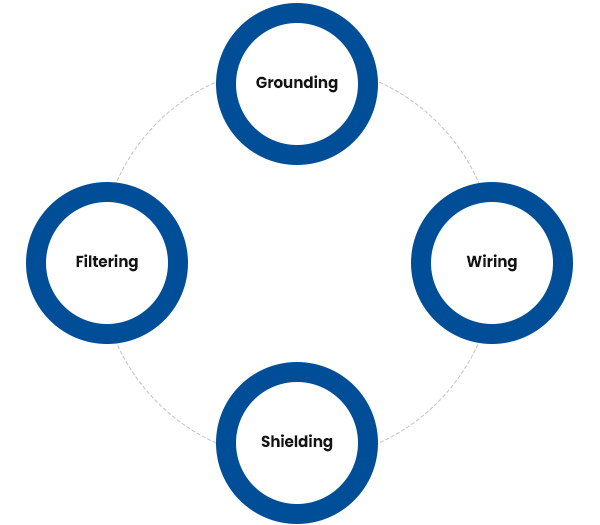EMI Countermeasure
We are pleased to provide detailed information
on TNC Co., Ltd.’s EMI technology capabilities and solutions.
To address the increasingly stringent domestic and international regulations on electromagnetic interference (EMI), significant investment in large-scale testing facilities and advanced technical expertise is required. However, this poses considerable challenges for small and medium-sized enterprises. While some may rely on the infrastructure of certified testing agencies, the associated costs remain a substantial burden.
To support such needs, TNC Co., Ltd. offers free EMI countermeasure services, focusing on conducted emissions (CE) and radiated emissions (RE). Backed by our high-quality line filters and a team of specialized EMI experts, we provide reliable and comprehensive solutions to help customers achieve full compliance.
Currently, countries around the world enforce regulations on electromagnetic interference (EMI), including those established by CISPR, FCC, EN, and VCCI. In particular, FCC and EN standards have become increasingly applicable to various types of electronic equipment. If these standards are not met, exporting such products to those respective countries may be impossible.
Information Technology Equipment
Electrical Devices and Motors
Broadcast Receivers
Receivers Using Semiconductors
Industrial, Scientific, and Medical (ISM) RF Equipment
·Prevent malfunction of electronic devices due to electromagnetic interference : which can lead to performance degradation or even safety hazards.
·Protect the nation's electromagnetic environment : including broadcast signals (TV, FM, AM) and wireless communications (Cellular, PCS).
·Protecting domestic industries through non-tariff technical barriers.
- Disadvantages in securing market share due to delays in product development schedules
- Reduced competitiveness caused by increased product costs
It refers to a device’s ability not to cause electromagnetic interference (EMI) to surrounding equipment or environments, and at the same time, to operate reliably in the presence of external electromagnetic influences.
In other words, the device complies with emission standards that prevent its electromagnetic emissions from affecting other devices, and with immunity standards that ensure it remains functional when exposed to EMI from external sources—thereby meeting the electromagnetic protection criteria.
Electromagnetic compatibility (EMC) testing refers to two types of emission tests and six types of immunity tests.
·Electromagnetic Emission Tests : Conducted Emission Test, Radiated Emission Test
·Electromagnetic immunity tests : Electrostatic Discharge (ESD) Test, Radiated Immunity Test, Conducted Immunity Test, Electrical Fast Transient (EFT) Test, Surge Immunity Test, Voltage Dips and Interruptions Test
To reduce electromagnetic interference (EMI), there are four main methods

The purpose is to direct leakage current from the device to the ground in order to protect both equipment and human safety, while also minimizing electromagnetic interference (EMI) caused by electromagnetic coupling of disruptive signals.
To minimize the noise flowing through a line, it is filtered according to the required frequency range.
To minimize noise along its transmission path (the line), the conductor should be made thicker and shorter to reduce impedance, and the noise source should be physically separated from susceptible components to limit electromagnetic coupling.
To minimize noise intrusion from the surrounding space, the device is enclosed in metal or conductive materials. This technique effectively blocks electromagnetic waves from entering, reducing the impact of radiated noise.
| Manufacturer | Product Name | Remarks |
|---|---|---|
| EME | Automotive Chamber | 6.7m(L) * 5.5m(W) * 3.9m(H) |
| R&S® | ESR7 | EMI test receiver 9 kHz to 7 GHz |
| R&S® | HFH2-Z6 | Active rod antenna 9 kHz to 30 MHz |
| R&S® | HK116E | Biconical Antenna 20MHz to 300MHz |
| R&S® | HL223 | Log-Periodic Broadband Antenna 200MHz to 1.3GHz |
| R&S® | ESH3-Z6 | V-Network 100 kHz to 200 MHz Continuous current of up to 100 A |
| Schwarzbeck | BBHA9120E | Double ridged broadband horn antenna Frequency range : 0.5 to 6 GHz |
| Schwarzbeck | NNBM 8124-400 | Single path LISN (Automotive) CISPR 25 / ISO 7637 100 kHz to 110 MHz Max. 400 A |
| FCC | F-70 | Current Monitor Probe 1 kHz – 100 MHz DC to 400 Hz : 350 A |
| EME | EMI Chamber | 5.2m(L) * 7.75m(W) * 4.02m(H) |
| R&S® | ESR3 | EMI test receiver 9 kHz to 3 GHz |
| R&S® | ESH2-Z3 | Voltage Probe 9kHz ~ 30MHz |
| Schwarzbeck | VULB9163 | Biconic Logarithmic Periodic Antennas (Hybrid) 30 - 3000 MHz |
| R&S® | ENV216 | two-line V-network 9kHz ~ 30MHz |
| R&S® | MDS-21 | Absorbing Clamp 30MHz ~ 1GHz |
| R&S® | ESPI3 | EMI test receiver 9 kHz to 7 GHz |
| ADVANTEST | R3361A | SPECTRUM ANALYZER 9kHz ~ 2.6GHz |
| LIG Nex1 | NS-30A | SPECTRUM ANALYZER 1kHz ~ 3GHz |
| LIG Nex1 | NS-30A | SPECTRUM ANALYZER 1kHz ~ 3GHz |
| EMCIS | LN2-16 | LISN(Line Impedance Stabilization Network) 9KHz ~ 30MHz |
| EMCIS | EA-300 | EMI Analyzer 9kHz~300MHz |
| EMCIS | LN4-50 | LISN(Line Impedance Stabilization Network) 150KHz ~ 30MHz |
| EMCIS | EA-2100 | EMI Analyzer 9kHz~300MHz |
| HP | 4395A | Network Analyzer 10KHz ~ 500MHz |
| HP | 4194A | GAIN PHASE ANALYZER 100Hz~40MHz |